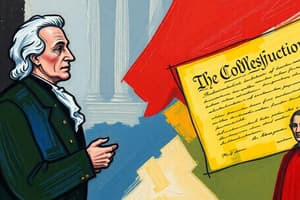Podcast
Questions and Answers
What strategic advantage did the Constitution's proponents hope to gain by pursuing a series of rapid ratifications in the initial state conventions?
What strategic advantage did the Constitution's proponents hope to gain by pursuing a series of rapid ratifications in the initial state conventions?
- To create an unstoppable wave of support, making it difficult for subsequent states to oppose ratification. (correct)
- To allow more time to address concerns raised by states with larger populations, such as Virginia and New York.
- To ensure that the process aligned with the consent of all thirteen states according to the Articles of Confederation.
- To diminish the influence of the Confederation Congress, as more states ratified the Constitution independently.
Why did the framers of the Constitution choose to have it ratified by state conventions rather than state legislatures?
Why did the framers of the Constitution choose to have it ratified by state conventions rather than state legislatures?
- State legislatures were deemed too efficient. Thus ratification via state conventions would encourage quick, decisive adoption.
- State conventions would allow for amendments to the constitution to be proposed prior to ratification.
- State legislatures were more easily influenced by public opinion, making them likely to reject the Constitution.
- State conventions would underscore the Constitution as fundamental law adopted through a solemn process, less vulnerable to shifting public sentiment. (correct)
Which concern was addressed by submitting the Constitution to specially elected conventions in each state, rather than directly to state governments?
Which concern was addressed by submitting the Constitution to specially elected conventions in each state, rather than directly to state governments?
- The potential resistance from state officials protective of their state's autonomy. (correct)
- The risk of the Confederation Congress rejecting the Constitution outright.
- The need to involve the federal judiciary in interpreting the constitution from its inception.
- The need to ensure that the new Constitution was popular amongst the states.
What was the significance of the Confederation Congress's decision to send the Constitution to the states 'with neither approval or rejection'?
What was the significance of the Confederation Congress's decision to send the Constitution to the states 'with neither approval or rejection'?
What was the intended effect of the Constitution's ratification process on the American populace?
What was the intended effect of the Constitution's ratification process on the American populace?
During the ratification debates, what potential obstacle did the Constitution's proponents face regarding their original mandate?
During the ratification debates, what potential obstacle did the Constitution's proponents face regarding their original mandate?
Why was the approval of states like Massachusetts, New York, Pennsylvania, and Virginia especially crucial to the success of the Constitution, even if the required nine states ratified it?
Why was the approval of states like Massachusetts, New York, Pennsylvania, and Virginia especially crucial to the success of the Constitution, even if the required nine states ratified it?
According to the ratification process outlined by the constitutional convention, what was the sequence AFTER the Confederation Congress transmitted the constitution to the state legislatures?
According to the ratification process outlined by the constitutional convention, what was the sequence AFTER the Confederation Congress transmitted the constitution to the state legislatures?
Which of the following best describes a primary argument made by the Anti-Federalists against the Constitution?
Which of the following best describes a primary argument made by the Anti-Federalists against the Constitution?
What was the significance of The Federalist papers during the ratification debate?
What was the significance of The Federalist papers during the ratification debate?
How did the 'Massachusetts Compromise' influence the ratification process?
How did the 'Massachusetts Compromise' influence the ratification process?
Which of the following factors contributed most significantly to the Federalists' success in the ratification debates?
Which of the following factors contributed most significantly to the Federalists' success in the ratification debates?
What was the primary concern that led Anti-Federalists to publish essays under pseudonyms?
What was the primary concern that led Anti-Federalists to publish essays under pseudonyms?
How did the ratification debates contribute to the development of American national identity?
How did the ratification debates contribute to the development of American national identity?
Why was ratification by New York and Virginia considered essential for the Constitution's success, even after the required number of states had ratified it?
Why was ratification by New York and Virginia considered essential for the Constitution's success, even after the required number of states had ratified it?
Which of the following best characterizes the Anti-Federalists' view of a strong central government?
Which of the following best characterizes the Anti-Federalists' view of a strong central government?
How did the Federalists leverage the perceived failures of the Articles of Confederation to support their arguments for the Constitution?
How did the Federalists leverage the perceived failures of the Articles of Confederation to support their arguments for the Constitution?
What distinguishes the ratification of the Constitution in the United States as a pivotal moment in political history?
What distinguishes the ratification of the Constitution in the United States as a pivotal moment in political history?
Flashcards
Constitutional Ratification Process
Constitutional Ratification Process
A 4-stage process: submission to Congress, transmission to state legislatures, election of state convention delegates, ratification by at least nine states.
Why Conventions Were a Good Idea
Why Conventions Were a Good Idea
Putting the Constitution in the hands of specially elected conventions and requiring only nine states' approval.
National Unity
National Unity
To induce Americans to think of themselves as a unified nation, encouraging support beyond state borders.
Ratification Momentum
Ratification Momentum
Signup and view all the flashcards
Potential Problem with Ratification
Potential Problem with Ratification
Signup and view all the flashcards
Congress's Role
Congress's Role
Signup and view all the flashcards
Major States Resistance
Major States Resistance
Signup and view all the flashcards
Congress's Neutral Position
Congress's Neutral Position
Signup and view all the flashcards
Federalists
Federalists
Signup and view all the flashcards
Anti-Federalists
Anti-Federalists
Signup and view all the flashcards
The Federalist Papers
The Federalist Papers
Signup and view all the flashcards
Anti-Federalist Writings
Anti-Federalist Writings
Signup and view all the flashcards
State Ratifying Conventions
State Ratifying Conventions
Signup and view all the flashcards
Early Ratifying States
Early Ratifying States
Signup and view all the flashcards
Massachusetts Compromise
Massachusetts Compromise
Signup and view all the flashcards
Recommended Amendments
Recommended Amendments
Signup and view all the flashcards
Bill of Rights
Bill of Rights
Signup and view all the flashcards
National Political Community
National Political Community
Signup and view all the flashcards
Study Notes
- The Constitution's ratification process spanned from September 1787 to July 1788.
Four-Stage Ratification Process
- Submission of the Constitution to the Confederation Congress was the first stage.
- The second stage included Congress transmitting the Constitution to state legislatures.
- The third stage involved the election of delegates to state conventions for Constitution consideration.
- Ratification by at least nine of the thirteen state conventions was the final stage.
Reasons for the Four-Stage Process
- It reflected the political realities and principles of 1787-1788.
- It avoided hostility from state officials protective of their sovereignty.
- The Constitution was viewed as fundamental law, needing more solemn adoption than legislative approval.
- It aimed to foster a national identity by encouraging Americans to look beyond state borders.
- Proponents hoped for quick initial ratifications to build unstoppable momentum.
Potential Issues
- Claims of violating the mandate to suggest amendments to the Articles of Confederation could arise.
- The Confederation Congress might reject, rewrite, or call for a second convention.
- States could refuse to elect ratifying conventions.
- Enough state conventions might reject the Constitution, preventing its implementation.
- Failure of key states like Massachusetts, New York, Pennsylvania, and Virginia to ratify could cripple the Constitution.
Sending Out the Constitution
- On September 28, 1787, the Confederation Congress sent the Constitution to the states without endorsement after three days of debate.
- This neutral stance was a Federalist compromise to avoid controversy.
- It avoided arguments that the Constitutional Convention exceeded its authority.
- The decision shifted responsibility to the states and the people to decide its fate.
- State legislators decided to hold state conventions, which confirmed the constitution’s legitimacy.
Federalists
- They supported the Constitution.
- Argued that the nation's problems stemmed from the weak Confederation.
- Believed the Constitution was essential for preserving American liberty and independence.
- They offered a solution during a national crisis.
- Well-organized, well-financed, and accustomed to national-level thinking.
- Had the support of George Washington and Benjamin Franklin.
Anti-Federalists
- Stated that the Constitution would destroy American liberty and betray the Revolution's principles.
- Their strongest argument was the lack of a bill of rights.
- Enjoyed support from most state politicians and the public's distrust of strong central government.
The Newspaper and Pamphlet War
- Federalists and Anti-Federalists published numerous essays under classical pseudonyms.
Federalist Writings Included
- The Federalist Papers by Alexander Hamilton, James Madison, and John Jay (Publius).
- John Jay's Address to the People of the State of New York.
Anti-Federalist Writings Included
- The Letters of Brutus, attributed to Robert Yates.
- Luther Martin's Genuine Information.
- Mercy Otis Warren's Observations on the New Constitution... by a Columbian Patriot.
- The Letters from the Federal Farmer to the Republican.
State Ratifying Conventions
- Every state except Rhode Island elected a ratifying convention in 1787-1788.
- North Carolina's convention adjourned without a vote.
- The first five ratifications occurred rapidly in Delaware, Pennsylvania, New Jersey, Georgia, and Connecticut
The Massachusetts Compromise
- Delegates recommended amendments for the new Congress to consider if the Constitution took effect.
- Adams and Hancock negotiated this compromise to win support for the Constitution.
- Subsequent state conventions, except Maryland's, recommended amendments.
- By July 26, 1788, eleven states had ratified, including the four critical states.
- The lists of recommended amendments and the promise to work for amendments (particularly a bill of rights), set in motion the process by which the Bill of Rights was added to the Constitution in 1789-1791.
Takeaways
- Ratifying the Constitution involved both political battles and deep constitutional debate.
- Marked the first time a nation's people freely chose their government.
- Was America’s first national political controversy.
- Ratification fostered a sense of national identity and a national political community.
- Debates over ratification shaped political discourse and continue to influence discussions about the Constitution today.
- The 1787-1788 argument is considered one of the most significant and impactful moments in American political history.
Studying That Suits You
Use AI to generate personalized quizzes and flashcards to suit your learning preferences.




